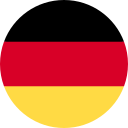Linguistik - Rechtschreibung und Typografie
Hier lernen Sie einige englische Wörter im Zusammenhang mit Orthographie und Typographie wie "Rechtschreibung", "Schreibschrift" und "kursiv".
Überprüfen
Lernkarten
Rechtschreibung
Quiz

the act or the ability of putting letters in the correct order to form a word

Rechtschreibung, Buchstabieren
the practice of using uppercase letters to signify the beginning of a sentence, proper nouns, and certain other grammatical elements for clarity and emphasis

Großschreibung, Verwendung von Großbuchstaben
the use of marks such as a period, comma, etc. in writing to divide sentences and phrases to better convey meaning

Interpunktion
a set of symbols or characters used to represent language in a visual or tangible form, allowing communication and the recording of information

Schriftsystem, Schreibmethode
a writing system that represents the sounds of a language using consistent and predictable symbols or characters, allowing for a direct correspondence between written and spoken forms

phonemische Orthographie, phonemisches Schriftsystem
a style of handwriting in which the letters are joined together in a flowing manner, often written with continuous strokes and without lifting the pen or pencil from the paper

Schreibschrift, verbundene Schrift
the art and technique of organizing written text in a visually appealing and readable manner

Typografie, Schriftgestaltung
a self-contained part of discourse that consists of one or more sentences dealing with a particular topic, indicated by indentation

Absatz, Paragraph
the degree of consistency between the spelling and pronunciation of words in a writing system, with shallow orthographies having a high degree of consistency such as in Spanish and deep orthographies having a lower consistency such as in English

orthografische Tiefe, Tiefe der Orthografie
the small letters in a writing system, contrasting with uppercase, and commonly used in regular text

Kleinbuchstabe, Minuskel
the set of capital or large letters in the Latin alphabet or other writing systems, typically used at the beginning of a sentence, for proper nouns, and for emphasis

Großbuchstabe, Versalbuchstabe
a linguistic or writing technique that uses pictures, symbols, or combinations of letters to represent words or sounds, often based on their phonetic similarity or association, creating visual puns or wordplay

Rebus-Prinzip, Rebus-Technik
a set of basic written symbols, representing the sounds of a language, which if put into correct orders form the words

Alphabet, ABC
a written character or symbol that represents an entire word or concept, rather than representing individual sounds or phonetic elements, as seen in some writing systems such as Chinese characters or Egyptian hieroglyphs

Logogramm, Ideogramm
the small decorative strokes or flourishes that extend from the ends of the main strokes of letters in a typeface, giving them a more traditional or formal appearance

Serife, Schraffe
a particular design or style of lettering, including the shape, size, and characteristics of the characters, that make up a complete set of fonts within a specific font family

Schriftart, Font
a different physical or visual representation of the same grapheme or character in a writing system

Allograph, grafische Variante
the smallest unit of a writing system that represents a distinct sound or phoneme in a language, such as a single letter, combination of letters, or symbol

Graphem, kleinste Einheit eines Schriftsystems
a font style characterized by thick, heavy lines for emphasis or visibility
a cursive script with slanted letters that are connected and flowing in appearance

Kursiv, kursive Schrift
a typeface or font that does not have small decorative strokes or serifs at the ends of the main letterforms, giving it a clean and modern appearance

serifenlos
the typographic variation of the digit "0" in which a diagonal slash is added across the zero to distinguish it from the letter "O" and indicate that it represents the numerical zero

durchgestrichene Null, Null mit Schrägstrich
a typographic term that refers to the combination of two or more letters or characters into a single interconnected glyph, often used to enhance readability or aesthetic appeal in certain typefaces or scripts

Ligatur, kombiniertes Glyph
(linguistics) a mark that is written below or above a letter indicating a difference in pronunciation

diakritisches Zeichen, Diakritikum
a diacritic used in various languages and writing systems to indicate different linguistic features such as stress, pitch, or vowel quality

Akut
the symbol ~ put over the letter n in Spanish, or a and o in Portuguese to indicate nasalization

Tilde, Tilde-Zeichen
the mark that appears as a small hook put under the letter 'c' indicating that it has a /s/ sound, rather than a /k/ sound

Cedille, diakritisches Zeichen in Form eines kleinen Hakens unter dem Buchstaben 'c'
the mark ^, placed over a vowel in some languages indicating contraction, length, etc.

Zirkumflex, Zirkumflexakzent
the diacritic mark ` placed above a vowel in some languages indicating an altered pronunciation in case of quality, quantity or pitch

Gravis, Grave
the mark ¨, put over a vowel indicating an articulation with rounding or fronting

Umlaut, Trema
a symbol or graphic representation that directly represents a concept or idea, often without relying on specific sounds or language, commonly used in pictographic or logographic writing systems

Ideogramm, grafisches Symbol
a letter in a word that is not pronounced when the word is spoken, although it may still affect the pronunciation or meaning of the word

stummer Buchstabe, stilles Zeichen
a letter used in some languages, such as Old English and Icelandic, to represent the voiced "th" sound, and is derived from the runic letter "d"

ein Buchstabe, der in einigen Sprachen
a diacritic mark used in some writing systems, such as Devanagari and Indic scripts, to indicate the absence of a vowel sound following a consonant, effectively suppressing the inherent vowel

Virama, ein diakritisches Zeichen
the art of producing beautiful handwriting using special writing instruments such as a dip or brush pen

Kalligraphie
a style of Chinese calligraphy that emerged during the Han Dynasty and was commonly used for official documents and bureaucratic purposes, characterized by its simplified and standardized form with square-shaped characters and clear strokes

Kanzleischrift, klerikaler Stil
an ancient style of writing used in China during the late Zhou Dynasty and the Qin Dynasty, characterized by its pictographic and abstract forms, with characters often featuring intricate and flowing lines

Siegelschrift, Siegelscript
a standardized style of Chinese calligraphy characterized by its balanced and uniform strokes, widely used for its readability and simplicity

reguläre Schrift, Standardstil
a semi-cursive style of Chinese calligraphy that exhibits a fluid and connected writing with simplified strokes, striking a balance between the cursive and regular scripts

halbkursiver Stil der chinesischen Kalligraphie, teilweise verbundene chinesische Schrift
the logographic characters adopted from Chinese characters and used in the Japanese writing system

Kanji, Kanji-Zeichen
a fundamental component of the Japanese writing system, comprising 46 characters that represent syllables and are utilized for native Japanese words, grammatical purposes, and verb endings

Hiragana, ein grundlegender Bestandteil des japanischen Schriftsystems
a component in the Japanese writing system, consisting of 46 characters that represent syllables and are primarily used for borrowed words, foreign names, onomatopoeia, and emphasis

Katakana, eine Komponente des japanischen Schriftsystems
the Chinese characters that are used in the Korean writing system, representing both meaning and sound and used in conjunction with the Korean alphabet, Hangul, to write words of Chinese origin or to clarify the meaning of Korean words

die chinesischen Schriftzeichen, die im koreanischen Schriftsystem verwendet werden
a letter or character from the runic alphabet, used in various Germanic languages during the early Middle Ages

Rune, Runenzeichen



